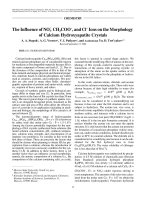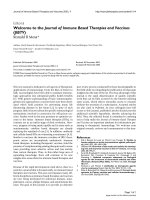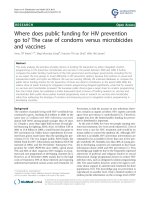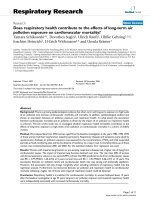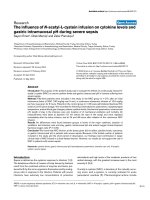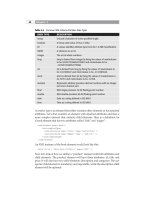Adapting to the work life interface the influence of individual differences, work and family on well being, mental health and work engagement
Bạn đang xem bản rút gọn của tài liệu. Xem và tải ngay bản đầy đủ của tài liệu tại đây (2.33 MB, 535 trang )
Adapting to the work-life interface: The influence of individual differences, work
and family on well-being, mental health and work engagement.
By
Prudence M. R. Millear
B. Sc. Ag. (Hons), Grad. Dip Psych, B. Psych. (Hons)
A thesis submitted in fulfilment of the requirements of the degree of
Doctor of Philosophy
School of Psychology and Counselling
Faculty of Health
Queensland University of Technology
February 2010
i
ii
Keywords
Bronfenbrenner, dispositional optimism, coping self-efficacy, affective commitment,
skill discretion, job autonomy, life satisfaction, psychological well-being, mental
health, work engagement, burnout, longitudinal modelling, gain spirals, loss spirals,
Conservation of Resources, resource caravans, working adults
iii
iv
Statement of Original Authorship
The work contained in this thesis has not been previously submitted to meet
requirements for an award at this or any other higher education institution. To the
best of my knowledge and belief, this thesis contains no material previously
published or written by another person except where due reference is made.
Signature ……………………………………………………………………………
Date …………………………………………………………………………………
v
vi
Publications and presentations arising from the PhD research
Journal articles
1. Millear, P.M & Liossis, P.L., Gain spirals and resource caravans: An integrated
longitudinal model of well-being, mental health and work engagement among
Australian workers, under review, Journal of Occupational and
Organizational Psychology
Book Chapters
1 Millear, P.M. & Liossis, P.L. (2010) Longitudinal modelling of individual
differences and the workplace: well-being and work engagement. Chapter 18
in Hicks, R.E. (Ed.) Personality and Individual Differences: Current
Directions. Brisbane, Australia: Australian Academic Press
2. Millear, P.M. & Liossis, P.L. Doing it for yourself: The choices and strategies of
managing the work-life challenge, accepted for publication, Wayfinding
through life‟s challenges: Coping and survival, Nova Science Publishers, NY,
K. Gow & M. Celinski (Eds)
Conference Presentations
2008
European Academy of Occupational Health Psychology conference at the
University of Valencia, November 2008, 2 presentations: 1 Longitudinal
modelling of well-being and mental health in Australian workers; 2 Exploring
burnout and work engagement in diverse occupations: A continuum or two
separate factors?
vii
2008 Australian Conference for Personality and Individual Differences (ACPID),
Bond University, (November, 2008) “Longitudinal modelling of the influence
of individual differences and the workplace on well-being and work
engagement”
2009 8th Industrial and Organizational Psychology conference, Sydney (June
2009), Paper Presentation, “An integrated longitudinal model of well-being,
mental health and work engagement among Australian workers”
viii
Acknowledgements
I would like to acknowledge and sincerely thank my supervisors, Dr Poppy
Liossis, my Principal Supervisor and Professor Ian Shochet, my Associate
Supervisor for the guidance and support that they have provided throughout my
candidature. I would also like to thank Dr Cameron Hurst and Dr Trish Obst for their
assistance with the Structural Equation Modelling that I undertook and thank
Cameron particularly for deciphering the process of longitudinal modelling. I would
like to thank my postgraduate friends for their unstinting support, coffee and
sympathy and thank my family and friends for helping where they could.
My greatest thanks are to my husband and children for bearing with me and
understanding the work involved in completing my thesis, in the middle of family
life, rugby and the house renovations. We have done this together.
ix
x
Abstract
Bronfenbrenner‟s Bioecological Model, expressed as the developmental equation, D
f PPCT, is the theoretical framework for two studies that bring together diverse
strands of psychology to study the work-life interface of working adults.
Occupational and organizational psychology is focused on the demands and
resources of work and family, without emphasising the individual in detail. Health
and personality psychology examine the individual but without emphasis on the
individual‟s work and family roles. The current research used Bronfenbrenner‟s
theoretical framework to combine individual differences, work and family to
understand how these factors influence the working adult‟s psychological
functioning. Competent development has been defined as high well-being (measured
as life satisfaction and psychological well-being) and high work engagement (as
work vigour, work dedication and absorption in work) and as the absence of mental
illness (as depression, anxiety and stress) and the absence of burnout (as emotional
exhaustion, cynicism and professional efficacy).
Study 1 and 2 were linked, with Study 1 as a cross-sectional survey and Study
2, a prospective panel study that followed on from the data used in Study1.
Participants were recruited from a university and from a large public hospital to take
part in a 3-wave, online study where they completed identical surveys at 3-4 month
intervals (N = 470 at Time 1 and N = 198 at Time 3). In Study 1, hierarchical
multiple regressions were used to assess the effects of individual differences (Block
1, e.g. dispositional optimism, coping self-efficacy, perceived control of time,
humour), work and family variables (Block 2, e.g. affective commitment, skill
discretion, work hours, children, marital status, family demands) and the work-life
interface (Block 3, e.g. direction and quality of spillover between roles, work-life
xi
balance) on the outcomes. There were a mosaic of predictors of the outcomes with a
group of seven that were the most frequent significant predictors and which
represented the individual (dispositional optimism and coping self-efficacy), the
workplace (skill discretion, affective commitment and job autonomy) and the worklife interface (negative work-to-family spillover and negative family-to-work
spillover). Interestingly, gender and working hours were not important predictors.
The effects of job social support, generally and for work-life issues, perceived
control of time and egalitarian gender roles on the outcomes were mediated by
negative work-to-family spillover, particularly for emotional exhaustion. Further, the
effect of negative spillover on depression, anxiety and work engagement was
moderated by the individual‟s personal and workplace resources.
Study 2 modelled the longitudinal relationships between the group of the
seven most frequent predictors and the outcomes. Using a set of non-nested models,
the relative influences of concurrent functioning, stability and change over time were
assessed. The modelling began with models at Time 1, which formed the basis for
confirmatory factor analysis (CFA) to establish the underlying relationships between
the variables and calculate the composite variables for the longitudinal models. The
CFAs were well fitting with few modifications to ensure good fit. However, using
burnout and work engagement together required additional analyses to resolve poor
fit, with one factor (representing a continuum from burnout to work engagement)
being the only acceptable solution. Five different longitudinal models were
investigated as the Well-Being, Mental Distress, Well-Being-Mental Health, Work
Engagement and Integrated models using differing combinations of the outcomes.
The best fitting model for each was a reciprocal model that was trimmed of trivial
paths. The strongest paths were the synchronous correlations and the paths within
xii
variables over time. The reciprocal paths were more variable with weak to mild
effects. There was evidence of gain and loss spirals between the variables over time,
with a slight net gain in resources that may provide the mechanism for the
accumulation of psychological advantage over a lifetime. The longitudinal models
also showed that there are leverage points at which personal, psychological and
managerial interventions can be targeted to bolster the individual and provide
supportive workplace conditions that also minimise negative spillover.
Bronfenbrenner‟s developmental equation has been a useful framework for
the current research, showing the importance of the person as central to the
individual‟s experience of the work-life interface. By taking control of their own life,
the individual can craft a life path that is most suited to their own needs. Competent
developmental outcomes were most likely where the person was optimistic and had
high self-efficacy, worked in a job that they were attached to and which allowed
them to use their talents and without too much negative spillover between their work
and family domains. In this way, individuals had greater well-being, better mental
health and greater work engagement at any one time and across time.
xiii
Table of Contents
Keywords .................................................................................................................... iii
Statement of Original Authorship ................................................................................ v
Publications and presentations arising from the PhD research .................................. vii
Acknowledgements ..................................................................................................... ix
Abstract ....................................................................................................................... xi
Table of Contents ...................................................................................................... xiv
List of Tables ............................................................................................................. xix
List of Figures .......................................................................................................... xxii
List of Appendices .................................................................................................. xxiii
Chapter 1: Theories and literature review of Bronfenbrenner‟s developmental
equation, applied to individuals and the work-life interface ........................................ 1
1.1 Bronfenbrenner‟s Bioecological Model of Human Development ..................... 2
1.2 Theories for D, the developmental outcomes, defined by well-being, mental
health, burnout and work engagement ..................................................................... 9
1.2.1 Well-being ................................................................................................... 9
1.2.1.1 Prevalence. ......................................................................................... 12
1.2.1.2 Stability of well-being ........................................................................ 14
1.2.1.3 Australian health and working provisions .......................................... 14
1.2.2 Mental health, as the absence of mental illnesses ..................................... 15
1.2.2.1 Costs and prevalence .......................................................................... 18
1.2.3 Burnout and work engagement ................................................................. 22
1.2.4 Bringing together well-being, mental health, burnout and engagement ... 26
1.3 Understanding the person, P, in the developmental equation .......................... 29
1.3.1 Generative dispositions and demand characteristics ................................. 29
1.3.2 Theories of the generative disposition of P, the person occupying and
managing multiple roles ..................................................................................... 30
1.3.3 Linkages between the generative disposition and positive affect, positive
psychology and resilience .................................................................................. 34
1.3.4 Gender and the generative disposition of the active participant, P ........... 39
1.3.5 Gender ....................................................................................................... 40
1.3.5.1 Gender and the work environment ..................................................... 41
1.3.5.2 Gender and parenting ......................................................................... 46
1.3.5.3 Gender and house work. ..................................................................... 48
1.3.6 Dispositional optimism ............................................................................. 50
1.3.7 Self-efficacy, as coping self-efficacy ........................................................ 56
1.3.8 Perceived control of time .......................................................................... 58
1.3.9 Theories of the demand characteristics of P, the person occupying and
managing multiple roles ..................................................................................... 60
1.3.10 Humour.................................................................................................... 64
1.3.11 Social skills and relationships ................................................................. 69
1.3.12 Conclusion for P, the Person ................................................................... 73
1.4 Understanding C, the Context for multiple roles ............................................. 75
1.4.1 Theories and models of C, the Context for multiple roles ........................ 75
1.4.2 Direction for the literature review of C, the context ................................. 80
1.4.3 Working hours and schedules ................................................................... 82
1.4.4 Demands and resources ............................................................................. 87
1.4.5 Affective commitment............................................................................... 93
1.4.6 Managerial support of work-life issues ..................................................... 95
xiv
1.4.7 Family characteristics................................................................................ 99
1.4.8 Multiple roles and spillover .................................................................... 104
1.4.9 Exploring the interactions between work and non-work domains .......... 106
1.4.9.1 Comparing types of jobs .................................................................. 108
1.4.9.2 Importance of roles .......................................................................... 110
1.4.9.3 Individual factors ............................................................................. 112
1.4.9.4 Workplace and family factors .......................................................... 113
1.4.10 Exploring work-life balance and work-life fit ...................................... 120
1.4.11 Conclusions of the Context of the work-life interface .......................... 122
1.5 T, the time frame over which multiple roles develop and occur .................... 124
1.5.1 Longitudinal studies from a developmental perspective ......................... 130
1.5.2 Longitudinal studies from an organizational perspective ....................... 136
1.5.3 Conclusions for Time in the developmental equation............................. 142
1.6 Proposed research program ............................................................................ 143
1.6.2 Study 1 .................................................................................................... 143
1.6.3 Study 2 .................................................................................................... 145
Chapter 2, Study 1: Using hierarchical multiple regressions to explore the predictors
of well-being, mental illness, burnout and work engagement of working adults .... 147
2.1.1 Hypothesis for Study 1. ........................................................................... 148
2.2 Methods .............................................................................................................. 149
2.2.1 Participants .............................................................................................. 149
2.2.1.1 Recruitment ...................................................................................... 149
2.2.2 Internet survey development ................................................................... 150
2.2.3 Internet survey methodology .................................................................. 151
2.2.4 Measures ................................................................................................. 155
2.2.4.1 Demographics .................................................................................. 155
2.2.4.2 Schedules, education, job conditions and income. ........................... 156
2.2.4.3 Work-life fit, work-life balance, feeling busy and personal problems.
...................................................................................................................... 157
2.2.5 Reliabilities and details of the measures ................................................. 157
2.2.6 P, the Person: Generative disposition variables ...................................... 158
2.2.6.1 Dispositional optimism. ................................................................... 158
2.2.6.2 Coping self-efficacy ......................................................................... 158
2.2.6.3 Control ............................................................................................. 159
2.2.7 P, the Person: Demand characteristic variables ...................................... 161
2.2.8 C, the Context: Workplace conditions .................................................... 161
2.2.8.4 Managerial support for work-life issues .......................................... 162
2.2.8.5 Affective commitment ..................................................................... 162
2.2.9 C, the Context: The work-life interface .................................................. 163
2.2.10 Well-being, mental illness, burnout and work engagement .................. 164
2.2.10.3 Satisfaction with life domains ........................................................ 165
2.2.10.5 Burnout ........................................................................................... 166
2.2.10.6 Work Engagement .......................................................................... 166
2.2.11 Procedure............................................................................................... 167
2.2.12 Analytical strategy for the hierarchical multiple regression (HMR)
analyses ............................................................................................................ 169
2.3 Results ................................................................................................................ 174
2.3.1 Data cleaning and screening.................................................................... 174
2.3.2 Demographics ......................................................................................... 176
2.3.3 Scale construction and sample size ......................................................... 179
xv
2.3.4 Means, standard deviations and correlations between the variables ....... 180
2.3.5 Presentation of the results of the HMR ................................................... 189
2.3.6 Life satisfaction ....................................................................................... 191
2.3.7 Psychological well-being ........................................................................ 193
2.3.8 Satisfaction with work ............................................................................. 194
2.3.9 Work vigour ............................................................................................ 198
2.3.10 Work dedication .................................................................................... 200
2.3.11 Work absorption .................................................................................... 201
2.3.12 Depression ............................................................................................. 205
2.3.13 Anxiety .................................................................................................. 207
2.3.14 Stress ..................................................................................................... 210
2.3.15 Emotional exhaustion ............................................................................ 212
2.3.16 Cynicism................................................................................................ 215
2.3.17 Professional efficacy ............................................................................. 218
2.3.18 Summary of the significant predictors of the hierarchical multiple
regressions ........................................................................................................ 220
2.3.19 Post-hoc analysis: Examining moderation between the most common
predictors for the outcomes .............................................................................. 224
2.3.20 Post-hoc analysis: What happened to humour?..................................... 230
2.3.21 Post-hoc analysis: An examination of gender ....................................... 232
2.3.22 Post-hoc analysis: What predicts negative spillover? ........................... 234
2.3.23 Post-hoc analysis: Understanding positive spillover ............................. 236
2.4 Discussion .......................................................................................................... 238
2.4.1 Limitations and strengths of Study 1....................................................... 255
Chapter 3, Study 2: Longitudinal modelling ............................................................ 257
3.1.1 Hypothesis for Study 2 ............................................................................ 259
3.2 Methods .............................................................................................................. 259
3.2.1 Participants .............................................................................................. 259
3.2.2 Recruitment of participants, survey methods and materials ................... 260
3.2.3 General process for longitudinal modelling ............................................ 260
3.2.4 Introduction to SEM and associated terminology ................................... 261
3.2.5 Assessing model fit ................................................................................. 263
3.2.5.1 Normed Chi-Squared statistic. ......................................................... 264
3.2.5.2 Root Mean Square Error of Approximation (RMSEA). .................. 265
3.2.5.3 Akaike Information Criteria (AIC). ................................................. 267
3.2.5.4 Comparative Fit Index (CFI) ............................................................ 267
3.2.5.5 Expected Cross-Validation Index (ECVI)........................................ 268
3.2.6 Early SEM models .................................................................................. 269
3.2.7 Confirmatory Factor Analysis (CFA) ..................................................... 270
3.2.8 Models to be considered in the CFAs and for longitudinal modeling .... 271
3.2.9 Constructing composite variables for the longitudinal models ............... 273
3.2.10 Naming the composite variables ........................................................... 275
3.2.11 Calculations of the composite variables ................................................ 276
3.2.12 Analytical strategy for longitudinal modelling ..................................... 276
3.2.12.2 Model trimming.............................................................................. 280
3.2.13 Summary of methods used for the longitudinal modeling .................... 281
3.3 Results of the Longitudinal Modeling ................................................................ 282
3.3.1 Sample size and characteristics ............................................................... 282
3.4 Time 1 SEMs as a basis for longitudinal models ............................................... 286
3.5 Confirmatory factor analyses (CFAs) ................................................................ 288
xvi
3.5.1 Confirmatory factor analysis of Well-Being model ................................ 289
3.5.2 Factor Score Weights for Well-Being model .......................................... 290
3.5.3 Confirmatory factor analysis of the Mental Distress model ................... 292
3.5.4 Factor score weights for the Mental Distress model ............................... 294
3.5.5 Confirmatory factor analysis for the Well-Being-Mental Health model 295
3.5.6 Factor score weights for the Well-Being – Mental Health model .......... 297
3.5.7 Confirmatory factor analysis for the Work Engagement model, based on
the scales of burnout and work engagement .................................................... 297
3.5.8 CFA for Burnout and Engagement alone ................................................ 299
3.5.8.1 One-factor CFA................................................................................ 299
3.5.8.2 Two factor CFA. .............................................................................. 300
3.5.9 Confirmatory Factor Analysis for the Work Engagement model ........... 301
3.5.10 Factor score weights for the Work Engagement model ........................ 302
3.5.11 Confirmatory factor analysis of the Integrated model .......................... 303
3.5.12 Factor score weights for the Integrated model ...................................... 308
3.6 Comparing the longitudinal models ................................................................... 310
3.6.1 Competing sets of longitudinal models ................................................... 310
3.6.2 The longitudinal Well-Being Model ....................................................... 313
3.6.3 The longitudinal Mental Distress model ................................................. 316
3.6.4 The longitudinal Well-Being – Mental Health model............................. 318
3.6.5 The longitudinal Work Engagement model ............................................ 319
3.6.6 The longitudinal Integrated model .......................................................... 323
3.6.7 Synchronous correlations, standardized regression weights and
significance of paths in the longitudinal models .............................................. 325
3.4.8 Individual Factors in the longitudinal models ......................................... 330
3.6.9 Positive Workplace Factors in the longitudinal models .......................... 330
3.6.10 Negative Spillover in the longitudinal models ...................................... 331
3.6.11 Overall Well-Being in the longitudinal models .................................... 331
3.6.12 Mental Illness in the longitudinal models ............................................. 334
3.6.13 Work Engagement in the longitudinal models ...................................... 335
3.6.14 Gain and loss spirals.............................................................................. 336
3.6.15 Squared multiple correlations from the models .................................... 340
3.6.16 Summary of the results of the longitudinal models .............................. 340
3.7 Discussion of the longitudinal models ............................................................... 343
3.7.1 Discussion of the Time 1 SEMs .............................................................. 344
3.7.2 Confirmatory factor analyses .................................................................. 346
3.7.3 Factor score weight from the CFAs ........................................................ 352
3.7.4 How factor score weights explain the relationships of the Integrated model
.......................................................................................................................... 355
3.7.5 The longitudinal models.......................................................................... 357
3.7.6 Stability and change in the longitudinal models ..................................... 359
3.7.6.1 Stability in the longitudinal models ................................................. 359
3.7.6.2 Change in the longitudinal models ................................................... 362
3.7.7. Limitations and strengths of Study 2 ..................................................... 370
3.7.8 Conclusions ............................................................................................. 371
Chapter 4: Discussion of research findings and conclusions ................................... 375
4.1 The developmental equation, D f PPCT ........................................................ 376
4.1.1 P, the person: The generative disposition ............................................... 376
4.1.2 P, the person: Their demand characteristics ............................................ 376
4.1.3 C, the context. ......................................................................................... 377
xvii
4.1.4 T, Time. ................................................................................................... 377
4.1.5 Summary of D f PPCT. ........................................................................... 378
4.2 Major findings ................................................................................................ 378
4.3 Interesting non-findings ................................................................................. 384
4.4 Applications of the research ........................................................................... 385
4.5 Future research ............................................................................................... 388
4.6 A final word ................................................................................................... 393
References ................................................................................................................ 395
Appendices ............................................................................................................... 442
Appendix A: Call for volunteers from the university alumni .................................. 442
Appendix B: Call for volunteers from the public hospital ....................................... 443
Appendix C. Time 2 Call to action .......................................................................... 444
Appendix D: Time 3 Call to action .......................................................................... 445
Appendix E: Second and third reminder calls to action ........................................... 446
Appendix F: Measures used in Study 1 and 2 .......................................................... 447
Appendix G: Simple slopes of the moderated regression analyses .......................... 454
Appendix H: Results of the Time 1structural equation modelling........................... 457
Appendix I: Confirmatory Factor Analyses for the longitudinal models................. 469
Appendix J: Results of the longitudinal models....................................................... 483
Appendix K: Terms and glossary for Study 2, Longitudinal modelling .................. 510
xviii
List of Tables
Table 2.1 Variables in each block as blocks are entered into hierarchical multiple
regressions …………………………………………………………………170
Table 2.2 Retention of participants over time, with percentages of original sample of
participants ………………………………………………………………...176
Table 2.3 Correlations between the variables included in the hierarchical multiple
regressions ……………………………………………………………182-188
Table 2.4 Results for the three steps of hierarchical multiple regressions for life
satisfaction ………………………………………………………………...192
Table 2.5 Results for the three steps for the hierarchical multiple regression for
psychological well-being ………………………………………………….195
Table 2.6 Results for the three steps for the hierarchical multiple regression for
satisfaction with work ……………………………………………………..197
Table 2.7 Results for the three steps for the hierarchical multiple regression for work
vigour ……………………………………………………………………...199
Table 2.8 Results for the three steps for the hierarchical multiple regression for work
dedication ………………………………………………………………….202
Table 2.9 Results for the three steps for the hierarchical multiple regression for work
absorption …………………………………………………………………204
Table 2.10 Results for the three steps for the hierarchical multiple regression for
depression………………………………………………………………….206
Table 2.11 Results for the three steps for the hierarchical multiple regression for
anxiety ……………………………………………………………………..208
Table 2.12 Results for the three steps for the hierarchical multiple regression for
stress ……………………………………………………………………….211
xix
Table 2.13 Results for the three steps for the hierarchical multiple regression for
emotional exhaustion ……………………………………………………...214
Table 2.14 Results for the three steps for the hierarchical multiple regression for
cynicism ……………………………………………………………...……217
Table 2.15 Results for the three steps for the hierarchical multiple regression for
professional efficacy ………………………………………………………219
Table 2.16 Summary of beta weights or the predictor variables for the hierarchical
multiple regressions..………………………………………………………223
Table 2.17 Results at Step 2, showing the significant interactions in the moderated
regression analyses……...…………………………………….……………227
Table 2.18 Simple slopes for the predictor variable (X1) and the criterion variable (Y)
at Low and High levels of the second moderating variable (X2).………….228
Table 2.19 Z scores for the indirect effects between humour and the outcomes,
through
dispositional
optimism
and
coping
self-efficacy
as
the
mediators…………………………………………………………………...231
Table 3.1 Latent and observed variables used in confirmatory factor analyses
……………………………………………………………………………...272
Table 3.2 Factor Score weights for composite variables for the Well-Being model
…………………………………………………………………………………292
Table 3.3 Factor Score weights for composite variables for the Mental Distress
model ………………………………………………………………….…...295
Table 3.4 Factor Score weights for composite variables for the Well-Being – Mental
Health model……………………………………………………………….298
Table 3.5 Factor Score weights for composite variables for the Work Engagement
model……………………………………………………………………….303
xx
Table 3.6 Factor score weights for the composite variables for the Integrated
model…………………………………………………………………….…309
Table 3.7 Improvement in the fit of models in the Well-Being model by including the
auto-lagged pathways from Time 1 to Time 3…………………………….311
Table 3.8 Results of longitudinal model testing for Well-Being Model…………..315
Table 3.9 Results of longitudinal model testing for Mental Distress Model ……..317
Table 3.10 Results of longitudinal model testing for Well-Being-Mental Health
models ………………………………………………………………….….320
Table 3.11 Results of longitudinal model testing for the Work Engagement model
……………………….……………………………………………………..322
Table 3.12 Results of longitudinal model testing for the Integrated model……….324
Table 3.13 Effect sizes of the standardized regression weights for the auto-lagged
and cross-lagged paths for all the longitudinal models ………….….332-333
Table 3.14 Squared Multiple Correlations for all models for Time 2 and Time 3
composite variables ……………………………………………………..…341
xxi
List of Figures
Figure 3.1 Simplified representation of the components used in SEM …………..262
Figure 3.2 Simplified representation of the confirmatory factor analyses………..271
Figure 3.3 Representation of the basic relationships to be tested in the longitudinal
analyses…………………………………………………………………….277
Figure 3.4 The best fitting model for the Well-Being model, E, the Trimmed
Reciprocal………………………………………………………………….315
Figure 3.5 The best fitting of Mental Distress model, E, the Trimmed Reciprocal
………………………………………………………………………….…..317
Figure 3.6 The best fitting of the Well-Being-Mental Health model, E, the Trimmed
Reciprocal ………………………………………………………………....320
Figure 3.7 The best fitting of the Work Engagement model, E, the Trimmed
Reciprocal …………………………………………………………………322
Figure 3.8 The best fitting of the Integrated models, E, the Trimmed Reciprocal
model…………………………………………………………………….....324
Figure 3.9 Weighting of the auto-lagged and cross-lagged paths in the Integrated
model.............................................................................................................339
Figure 4.1 Proposed cusp catastrophe for the relationship between work engagement
and burnout……………………………………………………………..….391
xxii
List of Appendices
Appendix A: Call for volunteers from the university alumni ………………….….441
Appendix B: Call for volunteers from the public hospital …………………….…..442
Appendix C. Time 2 Call to action ………………………..…………….………...443
Appendix D: Time 3 Call to action ………………………………………………..444
Appendix E: Second and third reminder calls to action……………….…………..445
Appendix F: Measures for Study 1 and 2 ……………………………..…………..446
Appendix G: Simple slopes of moderated regression analyses…..….....………….453
Appendix H: Results of the early structural equation modelling ………………….456
Appendix I: Confirmatory Factor Analyses for the longitudinal models.…………468
Appendix J: Results of the longitudinal models…………………………….……..482
Appendix K: Terms and glossary for Study 2, Longitudinal modelling …….…….510
xxiii
xxiv
Chapter 1: Theories and literature review of Bronfenbrenner‟s developmental
equation, applied to individuals and the work-life interface
The fullness of life is not just our working selves but also our non-work or
family selves. It is difficult to explain an individual‟s well-being and mental health
by only exploring the workplace factors that influence well-being and mental health,
without considering the individual‟s out-of-work responsibilities and activities,
whether any or all of these factors can have positive or negative influences, and
without considering the person engaged in all these roles. Yet much of the
organizational psychology literature has only recently included the positive effects of
work and without any particular focus on the „person‟ who is doing the work (Frone,
2003). Working adults are treated as a homogenous group of individuals, upon whom
workplace factors, such as working hours, have similar results. Where individual
differences are introduced, these are often limited to age, gender and negative affect
(for example, de Jonge et al., 2001). Whilst men and women are dissimilar in
obvious ways, such as the ability to bear children, gender is not the major difference
as this demarcation suggests (Barnett & Rivers, 2004). Similarly, using age reflects
chronological differences, but does not account for the current life stage of an
individual. For example, later childbearing in women could mean that comparing 40
year old women may not account for one having a teenage child, another a two year
old child, and another who has not had children. In the positive psychology literature,
whilst the characteristics and strengths of the individual are explored, individuals are
not studied in their usual context as working adults, or parents, or adult children
caring for aging parents.
In order to fully account for all influences on the working adult,
Bronfenbrenner‟s Bioecological Model of human development will form the
1
